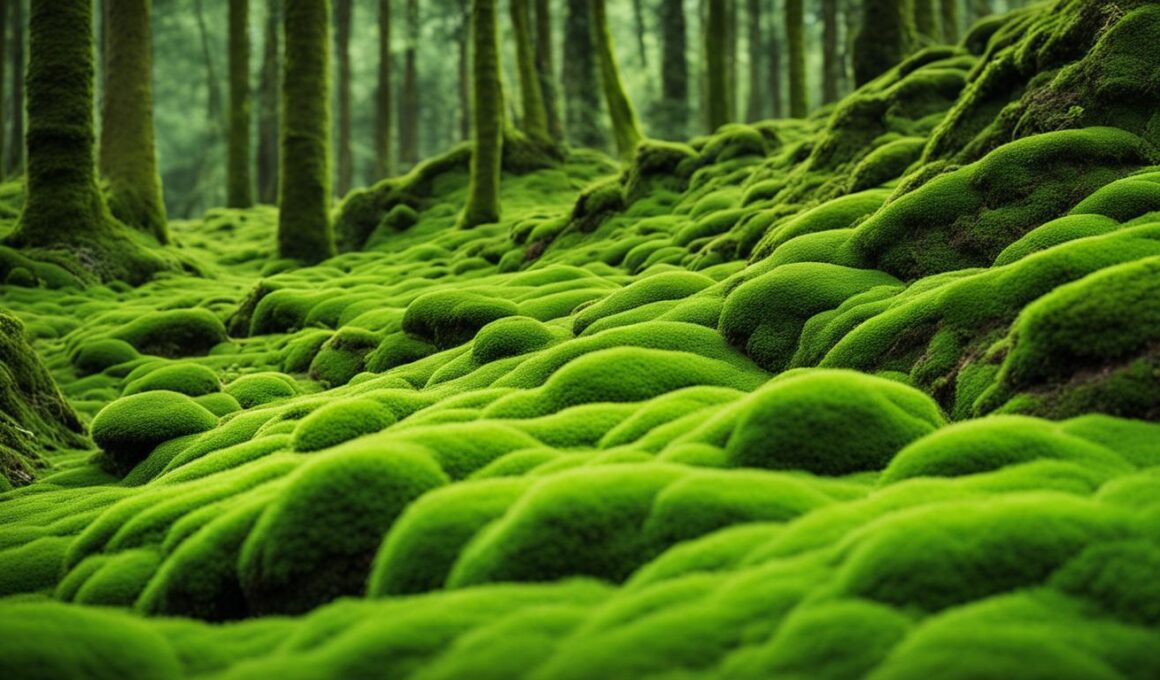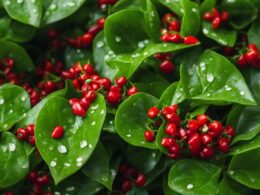When it comes to the world of biological organisms, there are often misconceptions and confusion surrounding certain species. One such case is the classification of moss. Many people wonder: is moss a fungus?
To uncover the biological truth and shed light on this matter, it is essential to understand the characteristics and classification of moss. Moss, scientifically known as Bryophyta, is a type of plant that thrives in damp or shady locations. It forms dense green clumps or mats, adding a touch of natural beauty to its surroundings.
Contrary to popular belief, moss is not a fungus. Moss falls under the division Bryophyta, while fungi belong to the kingdom Fungi. These two organisms have distinct biological characteristics and reproductive structures that set them apart.
By unraveling the truth about moss as a plant and dispelling the misconceptions about it being a fungus, we can gain a deeper understanding and appreciation for this unique form of life. Join us as we explore the characteristics, growth patterns, and differences between moss and fungus, allowing us to accurately classify and identify these organisms.
Moss Characteristics and Growth
Mosses are unique and fascinating plants that exhibit distinct characteristics and growth patterns. Understanding these aspects is essential for studying their ecology and distribution.
Moss Characteristics
Mosses are small, non-vascular plants that rely on different mechanisms for survival. They lack specialized vascular tissues like xylem and phloem, meaning they don’t have true roots, stems, or leaves. Instead, mosses absorb water and nutrients primarily through their leaves.
Mosses have simple leaves that are typically only one cell thick and attach to a stem or a rhizoid, a root-like structure that helps them anchor onto surfaces.
These unique leaves allow mosses to efficiently absorb moisture from their surroundings, making them well-adapted to damp environments.
Moss Growth and Reproduction
Mosses reproduce using spores, which are produced in structures called sporangia. The process begins when a haploid spore germinates and develops into a multicellular structure known as a gametophyte. This gametophyte is the dominant phase in the moss life cycle.
The gametophyte produces reproductive structures called gametangia, which contain the sex organs required for fertilization. After fertilization, the gametophyte develops sporophytes, which are short-lived structures that grow atop the gametophyte and produce spores.
The sporophytes rely on the gametophyte for water and nutrients, as they lack the necessary structures to absorb them directly from the environment.
Mosses have a remarkable ability to colonize various surfaces, including tree bark, rocks, and soil. They can establish themselves in a wide range of environments, from moist forests to arctic regions.
Ecology and Distribution
Understanding the characteristics and growth patterns of moss is crucial for studying their ecology and distribution. Mosses play vital roles in ecosystems, contributing to soil formation and moisture retention. They also provide habitats for various organisms, such as insects and invertebrates.
By studying moss characteristics and growth patterns, scientists can gain valuable insights into their ecological significance and how they interact with other organisms in their environment.
Moss vs Fungus: What Sets Them Apart?
When it comes to moss and fungus, it’s important to understand that they are two distinct types of organisms with different biological characteristics. Moss, for instance, belongs to the division Bryophyta and is classified as a plant. On the other hand, fungus falls under the kingdom Fungi.
Mosses are non-vascular plants that reproduce through spores and have a unique life cycle. These small plants have simple leaves and play a vital role in ecosystems as they contribute to soil formation, moisture retention, and provide habitat for various organisms. In contrast, fungi are eukaryotic organisms that obtain nutrients by decomposing organic matter or by forming mutualistic associations with other living beings.
One key difference between moss and fungus lies in their leaf structures. Mosses have leaves, albeit simple ones, while fungi do not have leaves or the ability to photosynthesize. This distinction is crucial in accurately identifying and classifying these organisms.
Another noticeable difference can be found in their reproductive structures. Mosses produce sporophytes, which are short-lived and dependent on the gametophyte for water supply and nutrients. Fungi, on the other hand, produce spores or spore-bearing structures, such as mushrooms. These varying methods of reproduction highlight the unique biological characteristics of mosses and fungi.
Understanding the differences between moss and fungus is important for accurate classification and identification. By recognizing that moss is a plant, we can appreciate its ecological significance and distinguish it from fungi. Mosses’ ability to thrive in diverse environments, from moist forests to arctic regions, showcases their adaptability and resilience.
Now that you are familiar with the differences between moss and fungus, you can confidently recognize and appreciate these distinct organisms in the natural world.
Key differences between moss and fungus:
- Moss belongs to the division Bryophyta, while fungus is part of the kingdom Fungi.
- Mosses are non-vascular plants, while fungi are eukaryotic organisms.
- Mosses have simple leaves, while fungi do not have leaves or the ability to photosynthesize.
- Mosses reproduce through sporophytes, while fungi produce spores or spore-bearing structures.
What Makes Moss Different from Fungi and What Classifies Poplar as a Hardwood?
Moss differs from fungi in that it is a non-vascular plant, lacking the specialized tissues for water transport. Unlike fungi, mosses perform photosynthesis and have simple leaves. As for “is poplar a hardwood,” poplar is classified as a hardwood due to its denser and typically tougher wood compared to softwoods.
Conclusion
In conclusion, moss is a fascinating plant that belongs to the taxonomic division Bryophyta. Unlike vascular plants, mosses do not have a traditional circulatory system, roots, or flowers. However, they possess unique adaptations that allow them to thrive in various habitats, forming dense clumps or mats in damp or shady locations.
Mosses reproduce through the dispersal of spores and have a distinct life cycle dominated by a haploid gametophyte generation. This reproductive strategy sets mosses apart from fungi, which belong to a separate biological kingdom. Mosses and fungi have different characteristics, including leaf structures, modes of nutrition, and reproductive structures.
Understanding the differences between moss and fungus is crucial for accurate identification and classification. By recognizing moss as a plant, we can appreciate its ecological significance. Mosses play a vital role in ecosystems, contributing to soil formation, retaining moisture, and providing habitat for a variety of organisms. Their unique beauty and ability to thrive in challenging environments make them an essential part of the natural world.









